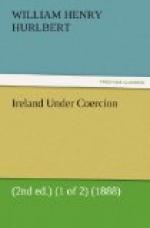In one glorious landlocked bay, we saw not a single boat riding. Our driver said, “The fishermen all live on Tory Island, and send their fish to Sligo. The people on the mainland don’t like going out in the boats.”
Lord Ernest tells me there is a movement to have a telegraph station set up on Tory Island, to announce the Canadian steamers coming into Moville for Deny.
We found Falcarragh, or “Cross-Roads,” a large clean-looking village, consisting of one long and broad street, through which horses and cattle were wandering in numbers, apparently at their own sweet will.
Ballyconnell House, the seat of Mr. Wybrants Olphert, is the manor house of the place. As we drew near, no signs appeared of the dreadful “Boycott.” The great gates of the park stood hospitably open, and we drove in unchallenged past a pretty ivy-clad lodge, and through low, but thickly planted groves. A huge boulder, ruddy with iron ore, bears the uncanny and unspellable name of the “Clockchinnfhaelaidh,” or “Stone of Kinfaele.” Upon this stone, tradition tells us, Balor, a giant of Tory Island, chopped off the head of an unreasonable person named Mackinfeale, for complaining that Balor, under some prehistoric “Plan of Campaign,” had driven away his favourite cow, Glasgavlan.
Ballyconnell House, a substantial mansion of the Georgian era, stands extremely well. Over a fine sloping lawn in front, you have a glorious view of the sea, and of a very fine headland, known as “the Duke’s Head,” from the really remarkable resemblance it bears to the profile of Wellington. The winds have such power here that there are but few well-grown trees, and those near the house. About them paraded many game-hens, spirited birds, looking like pheasants. These, as we learned, never sleep save in the trees.
The “boycotted” lord of the manor came out to greet us—a handsome, stalwart man of some seventy years, with a kindly face, and most charming manners. His family, presumably of Dutch origin, has been established here since Charles II. He himself holds 18,133 acres here, valued at L1802 a year; and he is a resident landlord in the fullest sense of the term. For fifty years he has lived here, during all which time, as he told us to-day, he has “never slept for a week out of the country.” His furthest excursions of late years have been to Raphoe, where he has a married daughter. “Absenteeism” clearly has nothing to do with the quarrel between Mr. Olphert and his tenants, or with the “boycotting” of Ballyconnell.
The dragoons from Dunfanaghy had just ridden away as we came up. They had come over in full fig to show themselves, and to encourage the respectable Catholics of Falcarragh, who side with their parish priest, Father M’Fadden of Glena, and object to the vehement measures, promoted by his young curate, Father Stephens, recently of Liverpool. The people had received them with much satisfaction. “They had never seen the cavalry before, and were much delighted!”




